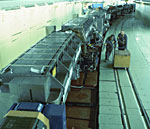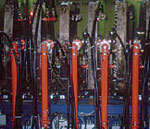|
 PS (Proton Synchotron) accelerator tunnel.
PS (Proton Synchotron) accelerator tunnel.
photo: CERN
|

The proton synchotron (PS) is the switchyard of CERN. All the particles used
in experiments at CERN go through the PS, are accelerated
to the speed of light, and fed to other machines in the
complex. The PS is the oldest of CERN’s accelerators,
and has been running continuously since 1959.
Particles coming from the linear accelerator have a relatively
low speed. Some of them, like protons and heavier particles,
are sent first to the PS booster for an initial "lift,"
and then passed on to the PS ring. The ring, made of a vacuum
pipe surrounded by magnets, measures 200 meters in diameter.
 A radio-frequency cavity in the PS.
A radio-frequency cavity in the PS.
photo: CERN
|
Like other circular accelerators, the PS requires dipole magnets to bend the particle beam around the ring. It also needs quadrupole magnets to keep the beam focused and so it doesn't run into the walls of the pipe. But unlike magnets in other machines, the PS magnets are combined, and fulfill both functions.
A device in the machine called the RF cavity is where
the acceleration takes place. The cavity can store electric
energy, which it transfers to a passing particle. Every
time a particle passes through the cavity, it gets accelerated
a little more. Once it’s reached the speed of light,
it can’t go any faster, and it begins to pick up mass
rather than speed. Using the PS, technicians can accelerate
the particles to whatever energy is needed for an experiment.
|